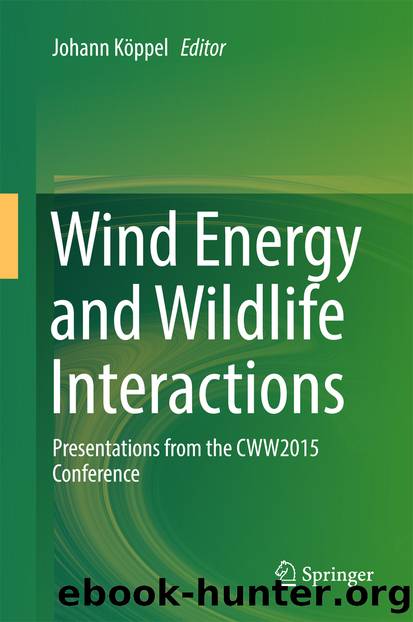Wind Energy and Wildlife Interactions by Johann Köppel

Author:Johann Köppel
Language: eng
Format: epub
Publisher: Springer International Publishing, Cham
Batcorders were operated with the following settings: Quality 20, threshold −36 dB, posttrigger 200 ms, and critical frequency 16 kHz. Batcorders ran continuously but produced valid data only during 71% of the nights sampled. Batcorder downtimes were mostly due to power, microphone or SD-card-failures, full SD-cards, or other technical problems with the detectors. Data from one turbine were excluded from the data set due to problems with microphone sensitivity. For the remaining 69 turbines, the mean number of nights with valid data was 126 per turbine (minimum 7, maximum 184) of a total of 184 nights sampled with a total sample time of 96,838 h. More than a million files were recorded (more than 400 Gbyte), of which 72,756 contained bat calls.
One temperature sensor was also installed (Sensor KTY81-110, Philips, Amsterdam, Netherlands), as well as one precipitation sensor (Sensor 5.4103.20.041, Adolf Thies GmbH, Göttingen, Germany) at most of the nacelles (68 temperature and 60 precipitation sensors). Temperature sensors were positioned in the nacelle floor at about half a meter distance from the detector microphone. Precipitation sensors were installed on top of the nacelle at the framework supporting turbine lighting and anemometer. The owners of the turbines provided access to the wind speed data measured with an anemometer recorded by the SCADA-System (Supervisory Control and Data Acquisition System) controlling the turbine. Wind speed data was available as mean values for 10 min intervals.
On two occasions at two different turbines, exceptionally high acoustic activity was recorded (1903 and 2071 recordings with bat calls, respectively) within a short time period (1.3 and 2.8 h). This activity was mostly caused by calls of the Common Pipistrelle (Pipistrellus pipistrellus) and is most likely attributed to swarming behaviour. P. pipistrellus is well known for swarming behaviour, which can result in a short-term occurrence of a large number of bats, especially around existing or potential roosts (Simon et al. 2004). On both occasions wind speed was very low (max. 2.4 and 1.9 ms−1) and so was the collision risk because rotors were only moving very slowly. Even a minor increase in wind speed of 0.5 ms−1 would have resulted in a large collision risk for the bats. Predictions of the frequency and occurrence of swarming behaviour in P. pipistrellus were not possible with such limited data (i.e. a sample size of 2 nights). Thus it was decided to exclude these swarming periods from the dataset, also because they appeared to be clear outliers in our analysis.
Download
This site does not store any files on its server. We only index and link to content provided by other sites. Please contact the content providers to delete copyright contents if any and email us, we'll remove relevant links or contents immediately.
The Complete Stick Figure Physics Tutorials by Allen Sarah(7264)
Secrets of Antigravity Propulsion: Tesla, UFOs, and Classified Aerospace Technology by Ph.D. Paul A. Laviolette(5237)
Thing Explainer by Randall Munroe(3849)
The River of Consciousness by Oliver Sacks(3498)
The Order of Time by Carlo Rovelli(3097)
How To by Randall Munroe(2969)
A Brief History of Time by Stephen Hawking(2911)
I Live in the Future & Here's How It Works by Nick Bilton(2900)
The Great Unknown by Marcus du Sautoy(2612)
What If?: Serious Scientific Answers to Absurd Hypothetical Questions by Randall Munroe(2589)
Midnight in Chernobyl by Adam Higginbotham(2432)
Blockchain: Ultimate Step By Step Guide To Understanding Blockchain Technology, Bitcoin Creation, and the future of Money (Novice to Expert) by Keizer Söze(2409)
Networks: An Introduction by Newman Mark(2304)
The Meaning of it All by Richard Feynman(2268)
Easy Electronics by Charles Platt(2252)
The Tao of Physics by Fritjof Capra(2204)
Midnight in Chernobyl: The Untold Story of the World's Greatest Nuclear Disaster by Adam Higginbotham(2126)
When by Daniel H Pink(2057)
Introducing Relativity by Bruce Bassett(2048)
